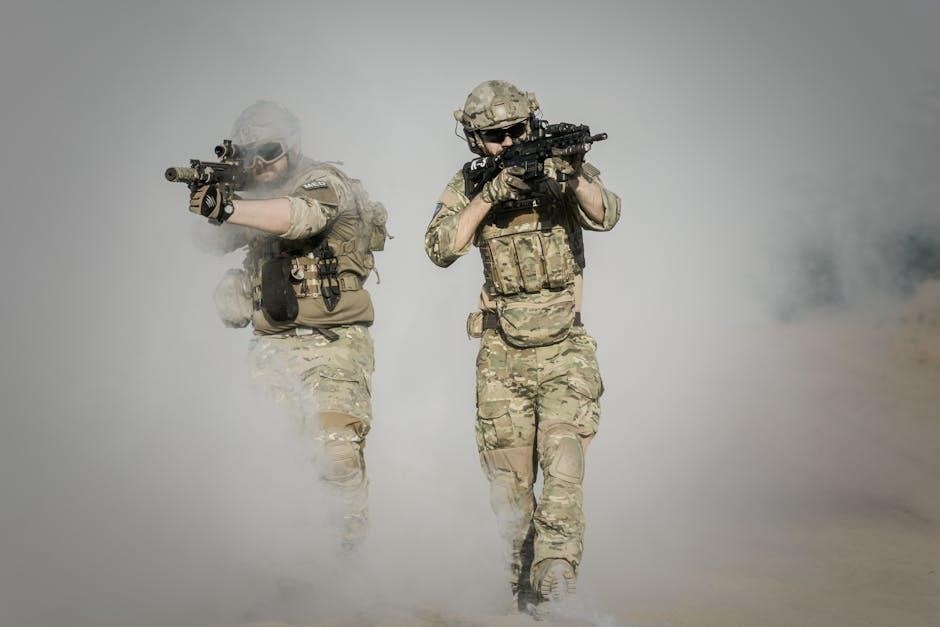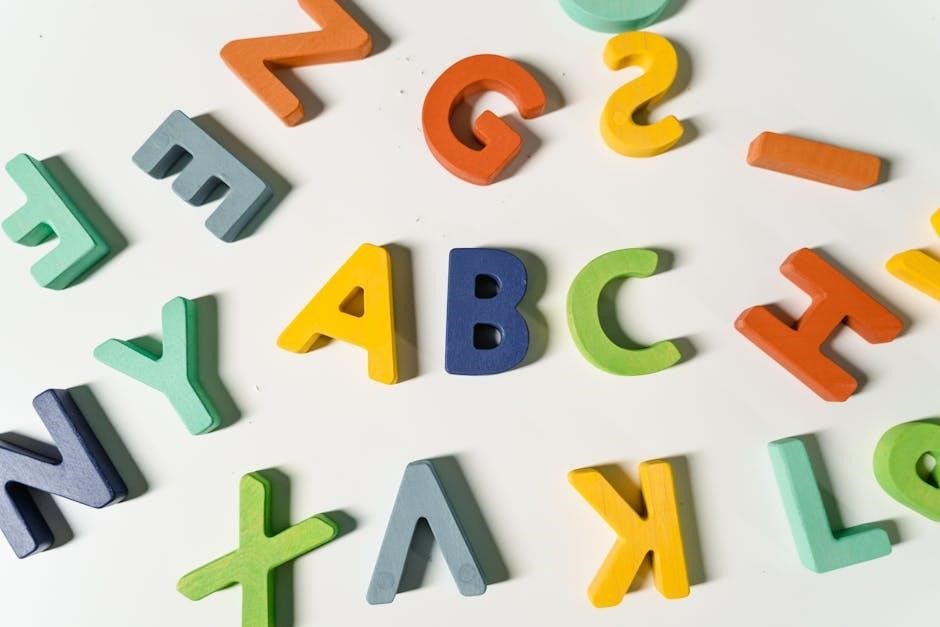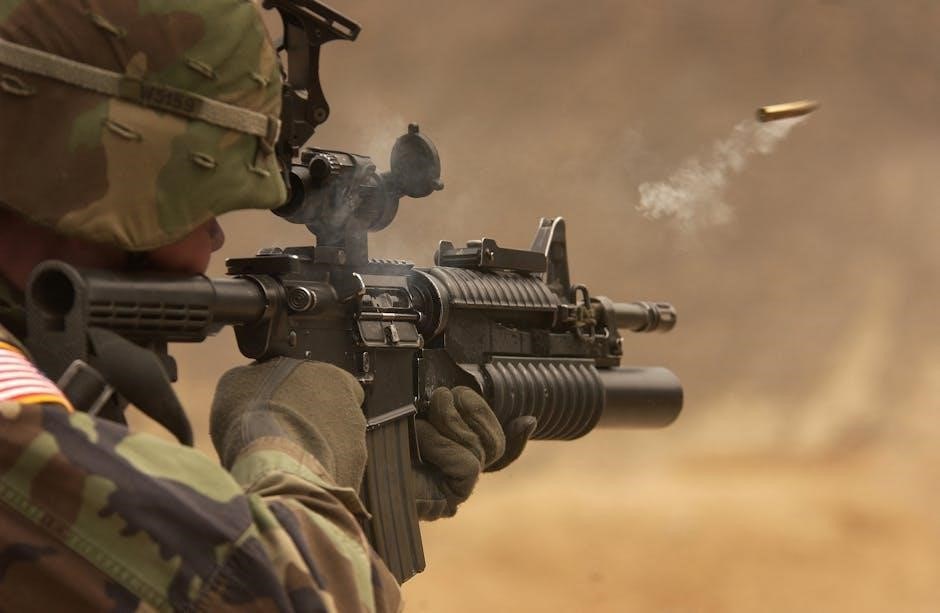The NATO Phonetic Alphabet PDF is a standardized communication tool used globally to ensure clear and accurate exchange of information. It converts letters into distinct code words, reducing errors in radio and phone communications. This system is essential for military, aviation, and maritime operations, providing a reliable method for spelling out names, codes, and messages. The PDF format offers a quick reference guide, making it easy to print and use for training or professional purposes. Its widespread adoption highlights its effectiveness in preventing misunderstandings, especially in high-stakes environments where clarity is crucial.
Overview of the NATO Phonetic Alphabet
The NATO Phonetic Alphabet is a standardized system of communication used to clearly convey letters and numbers in environments where standard pronunciation may be unclear. It assigns unique code words to each letter of the English alphabet, ensuring accurate transmission of information over radio, phone, or other communication systems. This system is widely adopted by military forces, aviation, and maritime industries to minimize misunderstandings, especially in high-stress or noisy conditions. The NATO Phonetic Alphabet PDF provides a concise and portable reference guide, making it easy to learn and use. Its universal application has made it an essential tool for professionals requiring precise communication, reducing errors and enhancing overall efficiency in critical operations.
Importance of the Military Alphabet in Communication
The military alphabet, also known as the NATO Phonetic Alphabet, plays a critical role in ensuring clear and accurate communication, particularly in high-stakes environments. By converting letters into distinct code words, it eliminates confusion caused by similar-sounding letters or poor transmission quality. This system is indispensable in military operations, aviation, and maritime industries, where precise communication is essential for safety and efficiency. The military alphabet PDF serves as a handy reference guide, making it easier to learn and use in training and professional settings. Its universal adoption underscores its effectiveness in reducing errors and enhancing clarity, making it a vital tool for professionals who rely on seamless communication to perform their duties effectively.

History and Development of the Military Alphabet
The NATO Phonetic Alphabet originated from earlier phonetic systems used in military communications. It was standardized by NATO members in the 1950s to improve clarity in radio transmissions, evolving into the universal standard used today.
Origins of the Phonetic Alphabet System
The phonetic alphabet system traces its roots to the early 20th century, when the need for clear communication in noisy environments became critical. The U.S; military and the International Telecommunication Union (ITU) developed early versions to reduce errors in radio transmissions. These systems used simple, distinct words to represent letters, ensuring clarity. For example, “Able” for A and “Baker” for B were common in early versions. Over time, these systems evolved, with NATO playing a key role in standardizing the alphabet globally in the 1950s. The development was driven by the need for a universal system to prevent miscommunication, especially in international operations. This foundation laid the groundwork for the modern NATO Phonetic Alphabet, now widely adopted across military, aviation, and maritime industries.
NATO’s Role in Standardizing the Alphabet
NATO played a pivotal role in standardizing the phonetic alphabet in the 1950s, addressing the need for a universal communication system. Prior to this, various organizations used different phonetic alphabets, leading to confusion, especially in international operations. NATO’s initiative ensured a consistent system, harmonizing communication across member countries. The standardized alphabet replaced earlier, less efficient systems, providing clear and distinct code words for each letter. This effort was crucial for military, aviation, and maritime operations, where precise communication is vital. NATO’s standardization facilitated seamless interactions globally, reducing errors and enhancing operational efficiency. Their efforts established the phonetic alphabet as an indispensable tool in modern communication.
Evolution of the Military Alphabet Over Time
The military alphabet has undergone significant evolution since its inception, driven by the need for clearer and more efficient communication. Early phonetic systems were often inconsistent, leading to misunderstandings in critical situations. In the 1920s, the International Telecommunication Union (ITU) introduced the first standardized phonetic alphabet, but it lacked universal adoption. NATO’s involvement in the 1950s revolutionized the system, creating a unified standard that replaced earlier, less effective versions. Over time, minor adjustments have been made to code words for better clarity and international compatibility. The modern NATO Phonetic Alphabet, finalized in 1956, remains the global standard for military, aviation, and maritime communications. Its enduring relevance is a testament to its effectiveness in reducing errors and ensuring precise information exchange across diverse operational environments.

Structure of the Military Alphabet
The military alphabet assigns unique code words to each letter, ensuring clear communication. Organized alphabetically, each letter from A to Z has a distinct phonetic equivalent, like Alpha for A and Bravo for B. This standardized system prevents confusion, especially in noisy environments.
Breakdown of Letters and Corresponding Code Words
The military alphabet pairs each letter with a unique code word to avoid confusion in communication. For example, A is Alpha, B is Bravo, and C is Charlie. This system continues through all 26 letters, ensuring clarity in spoken exchanges. The code words are chosen for their distinct pronunciation and ease of recognition, even in noisy environments. Key examples include D for Delta, E for Echo, and F for Foxtrot. The structure ensures that each letter is clearly understood, minimizing errors in critical communications. PDF charts of the military alphabet are widely available, providing a quick reference guide for learners and professionals alike. This standardized system is essential for maintaining accuracy in high-stakes environments.
Phonetic Alphabet Chart: A to Z
A Phonetic Alphabet Chart provides a visual representation of the military alphabet, listing each letter from A to Z alongside its corresponding code word. This chart is a essential tool for learning and referencing the NATO phonetic alphabet. It displays the 26 letters of the English alphabet, paired with unique code words such as A for Alpha, B for Bravo, and C for Charlie. The chart continues through to Z for Zulu, ensuring clarity in communication. PDF versions of the chart are widely available, offering a printable and shareable format. These charts are often used in training programs, military operations, and professional settings to improve accuracy and reduce errors. By organizing the alphabet in a structured and visually accessible way, the chart simplifies the process of mastering the phonetic system. It is a crucial resource for anyone seeking to understand or utilize the military alphabet effectively.
Special Cases and Exceptions in the Alphabet
The military alphabet includes specific rules to address potential ambiguities in communication. For instance, certain letters like M and N are easily confused, so their code words (Mike and November) are chosen to minimize errors. Similarly, the letter S is represented by Sierra, which is less likely to be mistaken for other sounds. The alphabet also accounts for numbers, with Zero and One used instead of their numeral forms to avoid confusion. In some cases, additional code words are introduced to handle accents or pronunciation differences. These adjustments ensure clarity in high-stakes environments like military operations or emergency communications. By addressing these special cases, the alphabet enhances accuracy and reliability in critical situations. This attention to detail makes it a robust system for clear and precise communication worldwide.

Practical Applications of the Military Alphabet
The military alphabet is widely used in military radio communications, aviation, and maritime industries to ensure clear and accurate exchanges. It’s also applied in civilian sectors like customer service and call centers to reduce errors and improve communication clarity. The PDF format makes it easily accessible for training and quick reference, enhancing its practicality in real-world scenarios.
Use in Military Radio Communications
The military alphabet is indispensable in military radio communications, ensuring clarity and precision in high-stakes environments. It replaces ambiguous letters with distinct code words, minimizing errors during critical operations. For instance, “Bravo” for B and “Charlie” for C eliminate confusion in noisy or stressful conditions. This system is universal, allowing personnel from different countries to communicate effectively, regardless of language or accent. It’s particularly vital for coordinating missions, relaying coordinates, and confirming identities. The NATO Phonetic Alphabet PDF serves as a quick reference, enabling rapid communication without misunderstandings. Its adoption across global military forces underscores its reliability and effectiveness in maintaining clear and accurate exchanges, even in the most challenging scenarios. This standardized approach ensures seamless communication, which is critical for operational success and safety.
Application in Aviation and Maritime Industries
The NATO Phonetic Alphabet plays a pivotal role in the aviation and maritime industries, where clear communication is paramount. In aviation, pilots and air traffic controllers use the alphabet to convey aircraft call signs, runway designations, and critical instructions, ensuring accuracy and safety. Similarly, in maritime operations, it is employed for ship-to-shore and ship-to-ship communications to avoid misunderstandings, especially in noisy environments. The military alphabet PDF provides a handy reference for professionals in these fields, enabling quick lookup of phonetic equivalents. This standardized system is essential for reducing errors in high-pressure situations, such as coordinating rescue operations or navigating through busy airspaces and waterways. Its universal adoption ensures seamless communication across borders and industries, making it a cornerstone of modern aviation and maritime safety protocols.
Civilian Use in Customer Service and Call Centers
The NATO Phonetic Alphabet has found practical applications in customer service and call centers, enhancing clarity in verbal communication. Representatives often use this system to accurately capture names, spellings, and sensitive information, especially when dealing with diverse accents or noisy environments. For instance, instead of repeating “M” multiple times, using “Mike” ensures clarity. Many companies provide their staff with military alphabet PDF charts or digital tools for quick reference, enabling efficient training and minimizing errors. This approach not only improves customer satisfaction but also streamlines operations, making it a valuable resource beyond its military origins. The universal nature of the phonetic alphabet ensures that it remains a reliable solution for clear communication in fast-paced, dynamic environments.

Downloading and Using the Military Alphabet PDF
The NATO Phonetic Alphabet PDF is easily downloadable, offering a printable chart for quick reference. It provides clear code words for each letter, ensuring accurate communication in professional settings.
How to Download the NATO Phonetic Alphabet Chart

Downloading the NATO Phonetic Alphabet Chart is straightforward and convenient. Visit reputable websites like TemplateRoller or other trusted sources offering free PDF downloads. Ensure the file is in printable format for easy reference. Many sites provide editable templates, allowing customization for specific needs. Once downloaded, save the chart as a PDF or print it directly. This resource is widely used in military, aviation, and customer service sectors to enhance communication clarity. The chart lists each letter alongside its corresponding code word, such as “Alpha” for A and “Bravo” for B, ensuring precise understanding. Its universal adoption makes it an essential tool for professionals and individuals alike. Regular updates ensure the chart remains relevant and aligned with global communication standards.
Printable PDF Versions for Easy Reference
Printable PDF versions of the NATO Phonetic Alphabet provide an ideal solution for quick and easy reference. These documents are designed to be user-friendly, allowing individuals to print them in high-quality formats. Many websites offer free downloadable PDFs that can be saved to devices or printed for offline use. The charts typically include the full alphabet from A to Z, with each letter paired with its corresponding code word, such as “Alpha” for A and “Bravo” for B. This format ensures clarity and reduces errors in communication. The printable versions are widely used in military training, aviation, and customer service sectors. Their portability and readability make them essential tools for professionals and individuals needing a reliable reference. Regular updates ensure the charts remain accurate and aligned with current standards.
Editable Templates for Customization
Editable PDF templates of the NATO Phonetic Alphabet offer flexibility for users needing tailored versions of the chart. These templates allow individuals or organizations to customize the content, such as adding logos, inserting specific codes, or highlighting particular sections. Many websites provide downloadable PDFs that can be edited using software like Adobe Acrobat or free online tools. This feature is particularly useful for training materials, where instructors might want to create exercises or quizzes. Users can also add notes or annotations to personalize the charts for their needs. The ability to customize ensures the alphabet remains relevant and adaptable for various industries, from military to civilian applications. This flexibility enhances usability and makes the Phonetic Alphabet more accessible for diverse purposes.

Learning the Military Alphabet
Mastering the NATO Phonetic Alphabet requires systematic practice and repetition. Utilize flashcards, online tools, and step-by-step guides to commit each letter and code word to memory. Regular practice ensures fluency and accuracy in communication, making it indispensable for professionals and enthusiasts alike.
Step-by-Step Guide to Mastering the Alphabet
Step 1: Begin by familiarizing yourself with the NATO Phonetic Alphabet chart, focusing on the unique code words assigned to each letter. Start with letters that are commonly confused, such as “B” (Bravo) and “P” (Papa).
Step 2: Use flashcards to memorize the associations between letters and their corresponding code words. Cover the code word and quiz yourself to reinforce memory retention.
Step 3: Practice pronunciation by listening to audio recordings of the alphabet. Ensure you mimic the intonation and stress patterns accurately.
Step 4: Engage in practical exercises, such as spelling your name or common phrases using the phonetic alphabet. Gradually increase complexity as you gain confidence.
Step 5: Incorporate real-life scenarios, such as simulating radio communications or role-playing with a partner. This helps apply the alphabet in context.
Step 6: Review and test yourself regularly to prevent forgetting. Use online tools or apps to track your progress and identify areas for improvement.
Consistent practice and repetition are key to mastering the military alphabet, ensuring clear and effective communication in any situation.
Flashcards and Memorization Techniques
Flashcards are an effective tool for memorizing the NATO Phonetic Alphabet. Create physical or digital cards with a letter on one side and the corresponding code word on the other. Quiz yourself by covering the code word and recalling it from memory. For enhanced retention, use mnemonics or associate code words with familiar objects or phrases. For example, link “Bravo” with “ball” or “Papa” with “father.” Group similar-sounding letters, such as “Bravo” and “Papa,” to practice distinguishing between them. Repeat the process regularly, focusing on letters you find challenging. Consistency is key to mastering the alphabet. Digital apps and online flashcard platforms also offer interactive features to make learning engaging. By combining these methods, you can efficiently memorize the entire alphabet and improve your communication skills. Regular practice ensures long-term retention and proficiency.
Online Tools and Apps for Practice
Various online tools and apps are available to help master the NATO Phonetic Alphabet. Websites like TemplateRoller offer interactive charts and digital flashcards, allowing users to study and test their knowledge. Specialized apps, such as Phonetic Alphabet trainers, provide quizzes, audio pronunciations, and progress tracking. Platforms like Quizlet enable users to create custom flashcard decks or use pre-made ones for focused practice. Many apps are available for both mobile and desktop, making it easy to practice anywhere. These tools often include features like spaced repetition and gamification to enhance learning. By leveraging these resources, individuals can improve their proficiency in the Phonetic Alphabet PDF and ensure accurate communication in professional or recreational settings. Regular use of these tools can significantly accelerate the learning process and reinforce long-term retention.

Related Concepts and Systems
The NATO Phonetic Alphabet is part of a broader family of communication systems designed to enhance clarity. It is closely related to International Morse Code, which uses sequences of dots and dashes. Another system is flag signals, where flags represent letters or messages. Additionally, other phonetic alphabets exist, such as the International Phonetic Alphabet (IPA), used in linguistics. These systems share the goal of reducing ambiguity in communication, making them essential in military, maritime, and aviation contexts. Understanding these related systems provides a deeper appreciation of the NATO Phonetic Alphabet’s role in global communication standards.
International Morse Code and Its Relation
International Morse Code is a complementary system to the NATO Phonetic Alphabet, using sequences of dots and dashes to represent letters, numbers, and punctuation. Developed by Samuel Morse in the 1830s, it was initially used for telegraph communication but later became essential in maritime and military contexts. Like the phonetic alphabet, Morse Code aims to eliminate ambiguity in communication, particularly in noisy or high-stakes environments. Each letter and number is assigned a unique Morse Code sequence, ensuring clarity and precision. While the NATO Phonetic Alphabet relies on spoken words, Morse Code is visual or auditory, making it a valuable backup system. Both systems are often used together in military and aviation settings to ensure reliable communication. The military alphabet PDF frequently includes Morse Code charts for quick reference, highlighting their interconnected role in global communication standards.

Flag Signals and Their Role in Communication
Flag signals are a visual communication system used to convey messages between ships, ships, and shore, or other entities. Each flag represents a letter, number, or specific phrase, allowing for clear communication over distances. Historically, flag signals were critical for naval operations, enabling coordination and commands without verbal exchange. Today, they are often used alongside the NATO Phonetic Alphabet to ensure redundancy and clarity in high-stakes environments. The military alphabet PDF frequently includes charts for flag signals, providing a quick reference for personnel. This dual system of flags and phonetic codes enhances reliability, especially in noisy or visually challenging conditions. The combination of visual and auditory tools ensures accurate communication, making flag signals an enduring component of military and maritime operations worldwide.
Comparison with Other Phonetic Alphabets
The NATO Phonetic Alphabet stands out among other phonetic systems due to its universal adoption and effectiveness. Unlike the International Morse Code, which uses dots and dashes, the military alphabet relies on code words for clarity. While the International Phonetic Alphabet (IPA) focuses on precise linguistic sounds, the NATO system prioritizes distinctiveness to avoid confusion. Other phonetic alphabets, such as the Western Union Phonetic Alphabet, differ in their code word selections, but the NATO version remains the most widely recognized. Its simplicity and effectiveness make it the preferred choice for military, aviation, and maritime communications. This standardized system ensures consistent understanding across languages and accents, solidifying its role as a global communication tool.

Miscellaneous Information
The military alphabet PDF is a versatile tool, reducing communication errors. It has cultural references in films and games, showcasing its global impact. Regular updates ensure its relevance and effectiveness in modern communication systems.
Common Misconceptions About the Alphabet
One common misconception about the military alphabet is that it is only used by the military. However, it is widely adopted in aviation, maritime, and civilian sectors for clear communication. Another myth is that the alphabet is entirely error-proof, but proper training is essential for accurate use. Some believe the system is outdated, yet it remains a global standard due to its effectiveness. Additionally, there is a misconception that the alphabet is complex to learn, but with practice, it becomes second nature. These misunderstandings highlight the importance of understanding the NATO Phonetic Alphabet as a universal tool for precise communication across diverse industries and languages.
Cultural References to the Military Alphabet
The military alphabet has become a cultural phenomenon, appearing in films, TV shows, and music. Movies like Sully and Top Gun feature its use in high-stakes communication scenarios. TV series such as NCIS and The Office have referenced it in episodes, showcasing its role in professional settings. Musicians have incorporated the alphabet into song lyrics for stylistic or thematic purposes. Video games, particularly those with military or strategic themes, often include it to enhance realism. Additionally, the alphabet has been used in advertising and branding to convey precision and clarity. Its presence in popular culture highlights its universal recognition and practical value. These references not only entertain but also educate audiences about the importance of clear communication, making the NATO Phonetic Alphabet a cultural icon beyond its functional purpose.
Future Developments and Updates
The military alphabet continues to evolve to meet modern communication needs. Advances in technology, such as AI-driven voice recognition systems, may integrate the NATO Phonetic Alphabet for enhanced accuracy. Efforts to expand its use in emerging industries, like cybersecurity and space exploration, are underway. Additionally, there is a push to create digital tools that simplify learning and application, such as interactive apps and real-time translation software. Future updates may include new code words to accommodate linguistic or cultural shifts. The focus remains on maintaining clarity and reducing errors in global communication. These developments ensure the military alphabet remains a vital tool for clear and effective expression across diverse sectors and technologies. Its adaptability underscores its enduring relevance in an ever-changing world.